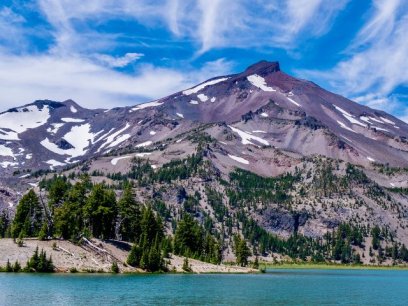
Did You Know?
- Snowflakes travel one to four miles from their cloud base to the surface of the planet, depending on the positioning of the clouds.
- Snowflakes are typically a half-inch in diameter, but can reach irregular sizes as large as two inches across.
Thinking of heading outside for some winter recreation this season? Whether you're skiing, snowboarding, hiking, snowshoeing, riding in a snowmobile, or setting up for a snowball fight, the type of snow on the ground can have an impact on your winter-weather activities. But, snow is snow, right? It's all frozen water, so how can there be different “types” of this cold-weather precipitation? Let's start at the top.
Snow Formation
For any precipitation to form, there needs to be enough moisture in the atmosphere that these microscopic particles of water vapor become too heavy to remain suspended in the air. This change in size and weight can occur when the tiny particles bump into each other and join together mid-air, or when they freeze around a solid core such as a piece of dust or grain of pollen. In the case of snow, these water vapor particles start their descent at a very low temperature, at or below 32°F, and remain in that temperature range as they travel from the cloud base to the surface of the planet, a distance that can be anywhere from one to four miles depending on the positioning of the clouds. Along that journey, the particles of frozen water vapor, or ice crystals, can still experience a variety of below-freezing temperatures, which can influence the structure and shape of each six-sided crystal. Under certain conditions, these snowflakes can grow beyond their usual half-inch diameter, reaching irregular sizes as large as two inches across.
Snow Ground Cover
Once on the ground, the snow can still change in texture, going through a metamorphosis in response to exposure to sunlight, wind, temperature fluctuations, and more precipitation. For instance, even if the air and ground temperatures remain below freezing, exposure to the elements can cause the top layer of the snow accumulation to melt and re-freeze, creating a crust on top of the snow. In areas that remain cold enough year round, the snowpack, or the total accumulation of ice and snow on the ground, can remain in place for years, developing layers of ice crystals that bear the markers of the weather conditions seen in the area since their deposition, resulting in differences in hardness, cohesion, strength, and even temperature throughout the snow mass. When enough new precipitation accumulates over top of the snow, the weight of this overlaying layer causes the ice crystals to undergo a type of geologic transformation, where hundreds of snowflakes recrystallize into larger and denser ice crystals, which can result in crystals up to one foot long, such as those seen at Alaska's Mendenhall Glacier.
Winter Recreation
For some outdoor enthusiasts, powder snow is prized above all else. This is snow that has relatively low moisture levels, and lacks the dense crust that can result from prolonged exposure to the elements. Some skiers argue that the best conditions for skiing come from storms that produce at least a foot of low density, new snow, which allows the skis to “float” through the accumulation with little resistance. This type of snow can be the result of a storm that gets colder over time, causing the driest, lowest-density snow to accumulate at the surface of the pile, with snow that becomes denser with depth. For others, such as those wishing to snowshoe, crusty snowpack might be more desirable—these conditions can occur when there's a large temperature variation or intense wind or sun applied to the snowpack, causing the surface to melt and refreeze.
Sources:
- National Snow & Ice Data Center. 2015. “All about Snow: How Snow Forms.” Accessed December 7. https://nsidc.org/cryosphere/snow/science/formation.html
- National Snow & Ice Data Center. 2015. “All about Snow: Types of Snow.” Accessed December 7. https://nsidc.org/cryosphere/snow/science/types.html
- National Weather Service. 2008. “Cloud Classifications.” NOAA. Accessed December 7, 2015. http://oceanservice.noaa.gov/education/yos/resource/JetStream/synoptic/clouds_max.htm#max
- NOAA. 2013. “How Do Snowflakes Form?” Accessed December 7, 2015. http://www.noaa.gov/features/02_monitoring/snowflakes.html
- Rocky Mountain National Park Environmental Education Staff. 2013. “Winter Ecology Teacher Guide.” NPS. http://www.nps.gov/romo/learn/education/upload/Winter-Ecology-Teacher-Guide-for-web.pdf
- Sobal, Tom. 2004. “The Crust Can Be the Best Part.” Snowshoe Magazine, April 19. Accessed December 7, 2015. http://www.snowshoemag.com/2004/04/19/the-crust-can-be-the-best-part/
- Steenburgh, W. James, and Trevor I. Alcott. 2008. “Secrets of the “Greatest Snow on Earth.”” Bulletin of the American Meteorological Society 1285-93. doi: 10.1175/2008BAMS2576.1
- University of Illinois at Urbana-Champaign WW2010. 1997. “Precipitation.” Accessed December 7, 2015. http://ww2010.atmos.uiuc.edu/%28Gh%29/guides/mtr/cld/prcp/home.rxml
- USGS. 2015. “USGS FAQs: Is Glacier Ice a Type of Rock?” Accessed December 7. http://www.usgs.gov/faq/categories/9750/3470


